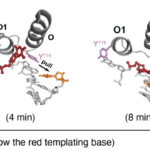Every time our cells divide, the DNA inside must be copied accurately to avoid mistakes that could be harmful to our health. Known as DNA synthesis, the precise sequence of steps has until now only been hypothesized. In a recent study, timestamps have been added to step-by-step snapshots, revealing a switch-up between two of the steps that, if replicated in additional studies, would upend our current assumptions of the process.
New COVID-19 Antibody Supersite Discovered
Scientists at the Berkeley Center for Structural Biology contributed resources and data to a recently-published study revealing a new site on the coronavirus spike protein used by antibodies to block the invasion of the virus into healthy cells. The discovery of this new antibody binding site will help scientists as they work to continue improving treatment and vaccine formulations for COVID-19 and its variants.
Inhalable COVID-19 Protection via Synthetic Nanobodies
Using protein structures obtained in part at the Advanced Light Source (ALS), researchers from the University of California San Francisco (UCSF) produced simplified antibodies (“nanobodies”) engineered to be highly effective at blocking SARS-CoV-2, the virus that causes COVID-19. Because they are extremely stable, these nanobodies can be aerosolized, stored at room temperature, and self-administered as needed, directly to affected nasal or lung tissues using nasal sprays or inhalers.
Scientists Map Coronavirus Protein Linked to Immune Evasion, Disease Severity
A team of UC Berkeley and Berkeley Lab researchers used X-ray crystallography performed at the Advanced Light Source (ALS) to determine the atomic structure of ORF8, a protein secreted by the SARS-CoV-2 virus that is thought to help the pathogen evade and dampen response from human immune cells.
Experimental Drug Targets HIV in a Novel Way
Using Berkeley Center for Structural Biology (BCSB) beamline 5.0.1, researchers from Gilead Sciences investigated a promising small-molecule drug, GS‑6207, that they developed to inhibit replication of the human immunodeficiency virus (HIV).
- « Previous Page
- 1
- 2
- 3
- 4
- 5
- …
- 12
- Next Page »
Was this page useful?







